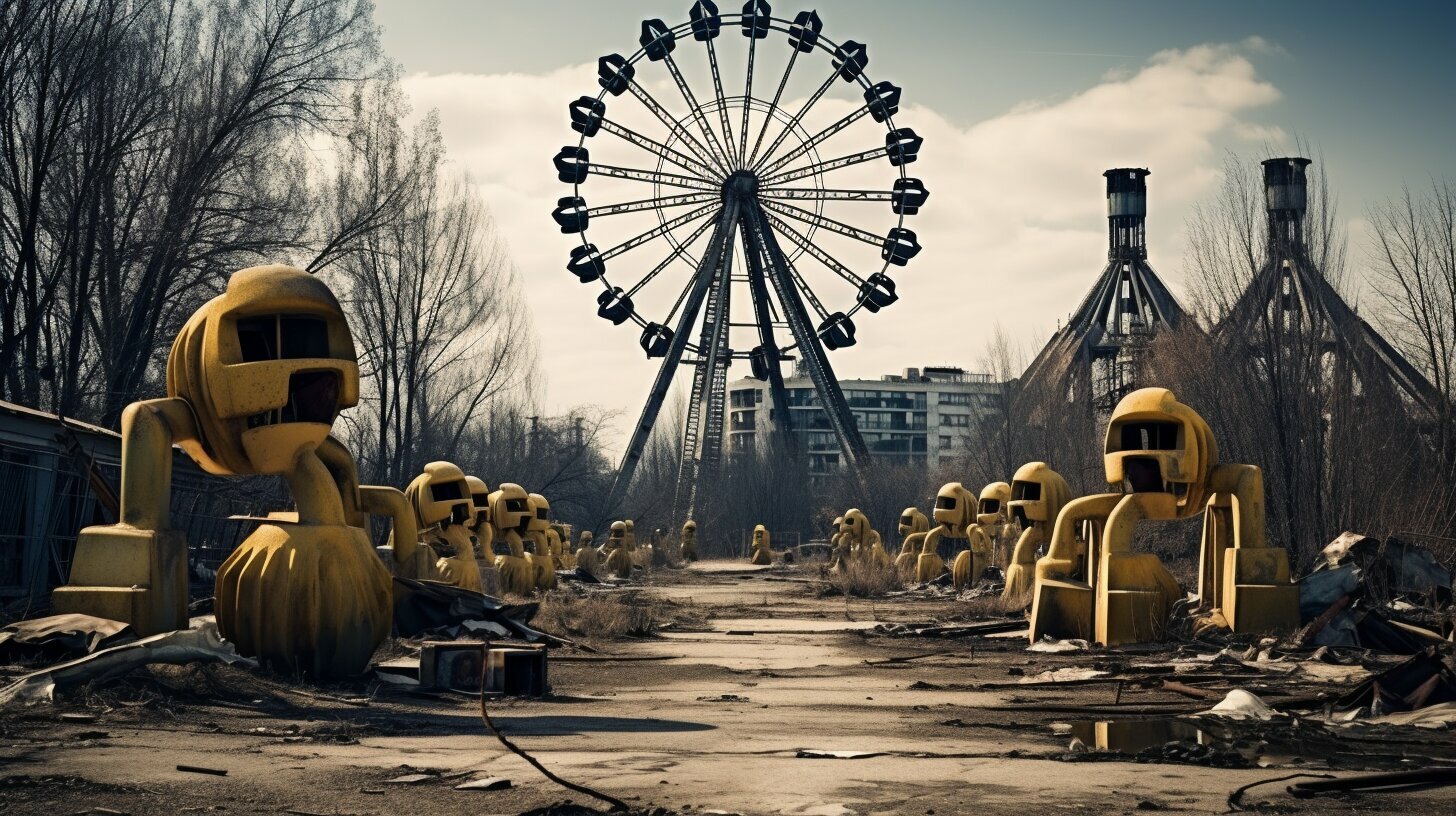What Country is Chernobyl in
Chernobyl, the infamous nuclear site, is located in Ukraine.
Key Takeaways:
- Chernobyl is situated in Ukraine, specifically in the Ukrainian SSR region.
- The Chernobyl power plant, where the nuclear accident occurred, is within Ukraine’s borders.
- Ukraine is the country associated with the Chernobyl disaster and its aftermath.
- Prior to the accident, life in the surrounding area was relatively normal, but everything changed in 1986.
- The Chernobyl disaster had far-reaching consequences, impacting not only Ukraine but also neighboring countries.
The History of Chernobyl
The history of Chernobyl is marked by the catastrophic nuclear accident that took place at the power plant in 1986. This event, known as the Chernobyl nuclear accident, is one of the most devastating nuclear disasters in history. The accident occurred during a safety test when a reactor at the Chernobyl power plant in the Ukrainian SSR experienced a critical failure.
The resulting explosion and fire released a significant amount of radioactive material into the atmosphere, causing widespread contamination and long-term health and environmental effects. The Chernobyl accident site, located near the town of Pripyat, became an exclusion zone, with restricted access to protect people from the radiation.
The Chernobyl power plant location has since become an important site for understanding nuclear safety and the consequences of accidents. It serves as a reminder of the dangers associated with nuclear power and the importance of strict safety protocols. The site is now undergoing a decommissioning process, with plans to transform it into a safe and environmentally friendly state. The lessons learned from the Chernobyl nuclear accident have influenced the development of nuclear energy policies and regulations worldwide.
In conclusion, the history of Chernobyl is forever marked by the catastrophic nuclear accident that occurred in 1986. The aftermath of the accident, contamination of the surrounding area, and the ongoing decommissioning efforts at the Chernobyl power plant serve as a reminder of the importance of safety and the potential risks associated with nuclear energy.
The Ukrainian SSR: The Region where the Chernobyl Disaster Occurred
The Ukrainian SSR, now part of independent Ukraine, is the region where the Chernobyl disaster occurred. This catastrophic event took place on April 26, 1986, at the Chernobyl Nuclear Power Plant, located near the town of Pripyat. The Ukrainian SSR was one of the constituent republics of the former Soviet Union, and Chernobyl was a crucial part of its energy infrastructure.
The Chernobyl power plant, situated in the Ukrainian SSR, played a vital role in the region’s electricity production. However, it was the site of one of the worst nuclear accidents in history. The explosion and subsequent release of radioactive material had devastating consequences not only for the surrounding area but also for the entire world. The Ukrainian SSR became forever linked to this tragic event that had far-reaching environmental, health, and social impacts.
The disaster led to the evacuation and displacement of thousands of people who called the Ukrainian SSR their home. It also highlighted the importance of nuclear safety and raised global awareness of the potential dangers associated with nuclear power. The aftermath of the Chernobyl tragedy resulted in significant changes in policies and regulations regarding nuclear energy.
The Legacy of Chernobyl in Independent Ukraine
In independent Ukraine, the legacy of the Chernobyl disaster is still felt to this day. Efforts have been made to mitigate the consequences and ensure the safety and well-being of affected communities. The Ukrainian government continues to monitor and study the long-term effects of radiation exposure, as well as implement measures to support those affected by the disaster.
Chernobyl has also become a symbol of human resilience and environmental recovery. The area around the former power plant now serves as a scientific and educational hub, allowing researchers and visitors to study the long-term effects of the accident and witness nature’s ability to reclaim once-devastated lands.
| Key Points: | Keywords: |
|---|---|
| The Ukrainian SSR | Ukraine Chernobyl |
| Chernobyl disaster | Chernobyl disaster country |
| Chernobyl power plant | Chernobyl power plant location |
Life Before the Disaster
Before the Chernobyl disaster, the region surrounding the power plant was home to a number of thriving communities. This area, located in the Ukrainian SSR, was known for its picturesque landscapes and rich agricultural resources. The residents of these communities enjoyed a close-knit and vibrant social life, deeply rooted in their connection to the land.
The power plant itself was a source of pride for the local population, as it symbolized progress and technological advancement. It provided employment opportunities and contributed to the region’s economic growth. The power plant’s workers and their families formed a tight-knit community, united by their common purpose and dedication to the facility.
Life in these communities was characterized by a harmonious balance between urban conveniences and rural charm. Villages were dotted with traditional wooden houses, surrounded by lush green fields and vast forests. The locals engaged in various activities, such as farming, fishing, and hunting, which sustained their livelihoods and brought them closer to nature.
| Key Aspects of Life Before the Disaster |
|---|
| Thriving communities |
| Picturesque landscapes |
| Agricultural resources |
| Close-knit social life |
| Industrial progress |
| Economic growth |
| Tight-knit worker community |
| Traditional wooden houses |
| Bountiful fields and forests |
The Chernobyl disaster had a devastating impact on these once-thriving communities. The explosion and subsequent release of radioactive material led to the evacuation and abandonment of the area. The tragedy forever altered the lives of the residents and left behind a haunting legacy. In the aftermath of the disaster, the region became an exclusion zone, off-limits to human habitation.
Today, the abandoned villages and decaying infrastructure serve as a chilling reminder of the vibrant life that once thrived here. The remnants of the past stand as a warning, highlighting the catastrophic consequences that can arise from technological failures. The story of life before the Chernobyl disaster is a testament to the resilience and strength of the communities that once called this region home.
The Legacy of Chernobyl’s Communities
The communities that existed before the disaster may be gone, but their memory lives on in the hearts of those who were affected. The legacy of these vibrant communities serves as a reminder of the importance of safety and responsible management in the pursuit of progress. It is a solemn tribute to the lives that were forever changed by the events of that fateful day.
The Aftermath of Chernobyl
The aftermath of the Chernobyl disaster had far-reaching effects on both the environment and the people living near the power plant. The explosion and subsequent release of radioactive materials contaminated the surrounding area, leaving a devastating impact on the region for years to come.
The environment suffered greatly, with vast stretches of land becoming uninhabitable due to high radiation levels. Forests, rivers, and agricultural fields were all affected, leading to significant ecological damage. The wildlife in the area also experienced negative consequences, with many species disappearing or showing signs of mutations as a result of exposure to radiation.
Moreover, the people living near Chernobyl faced severe health risks. The immediate effects of radiation exposure included acute radiation sickness, leading to illness and even death for some. In the long term, the incidence of cancer, particularly thyroid cancer, increased significantly among the affected population. Birth defects and other health issues also became more prevalent.
The aftermath of the Chernobyl disaster serves as a sobering reminder of the devastating consequences that can arise from a nuclear accident. It highlights the importance of robust safety measures and the need for continuous monitoring and assessment of nuclear power plants to prevent similar catastrophes from occurring in the future.
Key Effects of the Chernobyl Disaster
- Widespread environmental contamination
- Ecological damage and loss of biodiversity
- Health risks and increased incidence of cancer
- Higher rates of birth defects and other health issues
In conclusion, the aftermath of the Chernobyl disaster had profound and long-lasting impacts on both the environment and the people living near the power plant. It is a stark reminder of the potential dangers associated with nuclear energy, emphasizing the importance of stringent safety measures and continuous vigilance in the operation and regulation of nuclear facilities.
| Year | Event |
|---|---|
| 1986 | The Chernobyl nuclear disaster occurs |
| 1989 | The last reactor at the Chernobyl power plant is shut down |
| 1991 | The Ukrainian SSR becomes independent |
Current Status and Future Plans
Presently, efforts are being made to manage and contain the radioactive materials at the Chernobyl site, while also exploring opportunities for future use. The Ukrainian government, in collaboration with international organizations, has taken significant steps to address the aftermath of the Chernobyl nuclear accident.
The site is closely monitored, and measures have been implemented to secure the damaged reactor and prevent further release of radioactive particles into the environment. Various containment structures, such as the New Safe Confinement, have been constructed to enclose the damaged reactor and ensure the safety and stability of the site.
Furthermore, there are ongoing efforts to decontaminate the affected areas and mitigate the long-term environmental impact. These initiatives involve the removal and disposal of contaminated soil, as well as the implementation of radiation monitoring systems to continuously assess the radiation levels in the surrounding region.
Future Plans
In addition to the ongoing remediation efforts, there are discussions and plans for the future use of the Chernobyl site. One potential avenue is the development of sustainable energy projects, such as solar or wind farms, in the area surrounding the power plant. The ample land available and the existing infrastructure make it an attractive location for renewable energy generation.
Furthermore, there have been proposals to establish a research and development facility at Chernobyl, focusing on nuclear technology, radiation studies, and environmental monitoring. This would leverage the unique expertise gained from the disaster and enable scientists and researchers to study the long-term effects of nuclear accidents and improve safety protocols worldwide.
The ultimate goal is to transform Chernobyl from a symbol of disaster into a symbol of resilience and innovation. By harnessing the lessons learned from the past, Ukraine aims to create a safer and more sustainable future for the site and its surroundings.
| Current Status | Future Plans |
|---|---|
| Managing and containing radioactive materials | Exploring sustainable energy projects |
| Implementing decontamination measures | Establishing a research and development facility |
| Monitoring radiation levels | Transforming Chernobyl into a symbol of resilience |
Conclusion
Chernobyl’s location in Ukraine played a pivotal role in the nuclear accident that occurred in 1986, leaving a lasting impact on the region and the world. Situated in the Ukrainian SSR, which is now part of Ukraine, this disaster site continues to serve as a haunting reminder of the dangers associated with nuclear power.
The Chernobyl nuclear accident was a catastrophic event that resulted in the release of a massive amount of radioactive material into the environment. The consequences were devastating, both in terms of immediate human health effects and the long-term environmental impact. The location of Chernobyl in Ukraine magnified the severity of the disaster, as the fallout spread over a wide area, affecting not only the Ukrainian SSR but also neighboring regions.
The tragedy at Chernobyl brought attention to the risks and safety concerns associated with nuclear power plants. It led to significant changes in the industry, with stricter regulations and improved safety measures implemented worldwide. The people of Ukraine, especially those living near the disaster site, continue to deal with the aftermath of this tragedy, as the effects continue to be felt decades later.
Today, Chernobyl stands not only as a memorial to the lives lost and the communities affected but also as a symbol of the resilience of the human spirit. Efforts have been made to contain the radiation and mitigate the environmental impact. The site has become a tourist attraction, drawing visitors from around the world to witness the chilling remnants of what was once a thriving community.
FAQ
Q: What country is Chernobyl in?
A: Chernobyl is located in the Ukrainian SSR, which is now part of Ukraine.
Q: What is the history of Chernobyl?
A: Chernobyl’s history is marked by the nuclear accident that occurred at the power plant, which has become a significant site in the world.
Q: What is the Ukrainian SSR?
A: The Ukrainian SSR is the region where Chernobyl is located and is closely associated with the Chernobyl disaster.
Q: What was life like in Chernobyl before the disaster?
A: Prior to the nuclear disaster, Chernobyl and its surrounding area were home to a thriving community with its own unique way of life.
Q: What has been the aftermath of Chernobyl?
A: The aftermath of the Chernobyl disaster has had a profound impact on the surrounding area, with long-lasting effects on both the environment and the people living there.
Q: What is the current status of Chernobyl and are there any future plans for the site?
A: Chernobyl is now a regulated zone with limited access. There are ongoing efforts to manage the site and explore its potential for future use.



